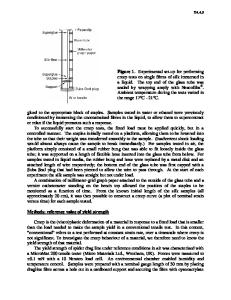Nanoscale Origins of Spider Dragline Mechanical Properties
- PDF / 109,066 Bytes
- 6 Pages / 612 x 792 pts (letter) Page_size
- 26 Downloads / 358 Views
Y4.7.1
Nanoscale Origins of Spider Dragline Mechanical Properties Jessika E. Trancik1, 2, Jan T. Czernuszka2, Fraser I. Bell3, and Christopher Viney2,3,4 Earth Institute, Columbia University, New York, NY 10027, USA. 2 Department of Materials, University of Oxford, Oxford OX1 3PH, United Kingdom. 3 Chemistry, School of Engineering and Physical Sciences, Heriot-Watt University, Edinburgh EH14 4AS, United Kingdom. 4 School of Engineering, University of California at Merced, Merced, CA 95344, USA. 1
ABSTRACT Several mechanical models, in which a material is treated as a composite of crystalline and amorphous and/or interphase material, were used to predict the tensile modulus of spider dragline along the fiber direction. The models included the Voigt average (which assumes that the fibers/crystals are continuous, and that the strain is the same in all components of the composite); a modified Halpin-Tsai model (which is suitable for predicting the longitudinal elastic modulus for short aligned fiber composites, and is thus more appropriate for silk); and the shear-lag or Cox model (which is a modification of the Voigt average that takes into account a discontinuous nature of stiff fibers/crystals and the resulting shear stress in the amorphous matrix). The latter two models yielded close approximations of an experimentally measured elastic modulus of Latrodectus hesperus (black widow spider) dragline under conditions of controlled temperature and humidity, given realistic inputs for the moduli of the individual components and the percent crystallinity. A literature model for the stress-strain behavior of silk [1] was also considered, in the context of our experimental results from transmission electron microscopy (TEM) and X-ray diffraction (XRD) studies of L. hesperus dragline. TEM and XRD results indicated a bimodal size distribution of ordered regions; one population of crystals has a mean size of 2 nm, and another spans the size range 40-120 nm. The average elastic modulus measured from L. hesperus dragline is 23 GPa - close to the 25 GPa theoretical modulus for the case of large crystals in Termonia's model. The tensile strength of L. hesperus dragline is ca. 1.7 GPa, close to the case predicted for small crystals in Termonia's model. A combination of the small and large crystals could explain the forced elongation behavior of L. hesperus dragline.
INTRODUCTION Spider draglines are a class of high mechanical performance natural polymers that, unlike many artificial polymers, are synthesized at room temperature and without the use of petrochemicals. There is considerable scientific and commercial interest in producing silk analogs that mimic the high mean breaking strength and toughness of the natural polymer, and that are environmentally friendly to manufacture [2]. A better understanding of the complex physical and chemical structure of native spider silks at all pertinent length scales, and in turn how this structure gives rise to silks’ unique mechanical properties, is important for our ability to understand
Data Loading...











